USB MITSUBISHI LANCER RALLIART 2014 8.G Display Audio Manual
[x] Cancel search | Manufacturer: MITSUBISHI, Model Year: 2014, Model line: LANCER RALLIART, Model: MITSUBISHI LANCER RALLIART 2014 8.GPages: 88, PDF Size: 11.63 MB
Page 55 of 88
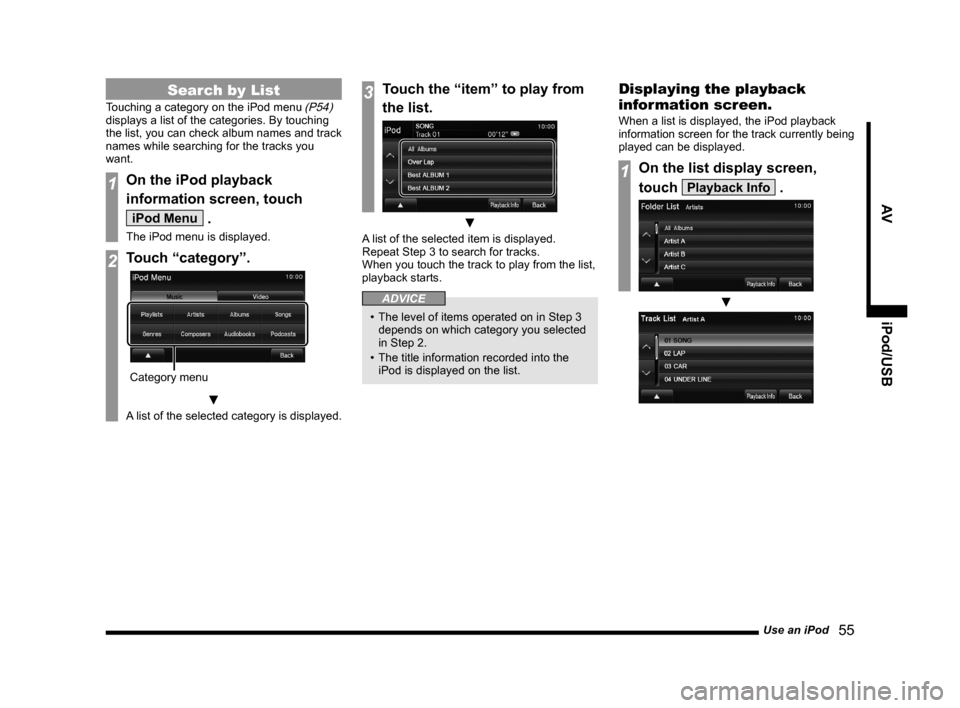
Use an iPod 55
AViPod/USB
Search by List
Touching a category on the iPod menu (P54)
displays a list of the categories. By touching
the list, you can check album names and track
names while searching for the tracks you
want.
1On the iPod playback
information screen, touch
iPod Menu .
The iPod menu is displayed.
2Touch “category”.
Category menu
▼
A list of the selected category is displayed.
3Touch the “item” to play from
the list.
▼
A list of the selected item is displayed.
Repeat Step 3 to search for tracks.
When you touch the track to play from the list,
playback starts.
ADVICE
• The level of items operated on in Step 3 depends on which category you selected
in Step 2.
• The title information recorded into the iPod is displayed on the list.
Displaying the playback
information screen.
When a list is displayed, the iPod playback
information screen for the track currently being
played can be displayed.
1On the list display screen,
touch
Playback Info .
▼
13MY_AVC(NAS).indb 552013/02/14 10:57:52
Page 57 of 88
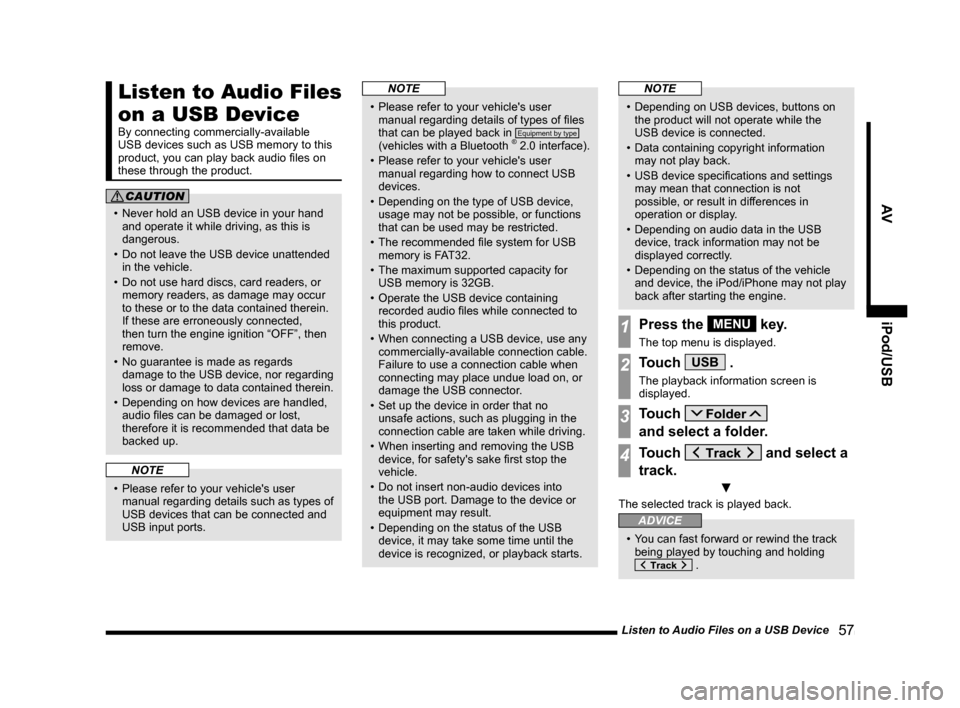
Listen to Audio Files on a USB Device 57
AViPod/USB
Listen to Audio Files
on a USB Device
By connecting commercially-available
USB devices such as USB memory to this
product, you can play back audio files on
these through the product.
CAUTION
• Never hold an USB device in your hand
and operate it while driving, as this is
dangerous.
• Do not leave the USB device unattended in the vehicle.
• Do not use hard discs, card readers, or memory readers, as damage may occur
to these or to the data contained therein.
If these are erroneously connected,
then turn the engine ignition “OFF”, then
remove.
• No guarantee is made as regards damage to the USB device, nor regarding
loss or damage to data contained therein.
• Depending on how devices are handled, audio files can be damaged or lost,
therefore it is recommended that data be
backed up.
NOTE
• Please refer to your vehicle's user manual regarding details such as types of
USB devices that can be connected and
USB input ports.
NOTE
• Please refer to your vehicle's user manual regarding details of types of files
that can be played back in
Equipment by type
(vehicles with a Bluetooth ® 2.0 interface).
• Please refer to your vehicle's user manual regarding how to connect USB
devices.
• Depending on the type of USB device, usage may not be possible, or functions
that can be used may be restricted.
• The recommended file system for USB memory is FAT32.
• The maximum supported capacity for USB memory is 32GB.
• Operate the USB device containing recorded audio files while connected to
this product.
• When connecting a USB device, use any commercially-available connection cable.
Failure to use a connection cable when
connecting may place undue load on, or
damage the USB connector.
• Set up the device in order that no unsafe actions, such as plugging in the
connection cable are taken while driving.
• When inserting and removing the USB device, for safety's sake first stop the
vehicle.
• Do not insert non-audio devices into the USB port. Damage to the device or
equipment may result.
• Depending on the status of the USB device, it may take some time until the
device is recognized, or playback starts.
NOTE
• Depending on USB devices, buttons on the product will not operate while the
USB device is connected.
• Data containing copyright information may not play back.
• USB device specifications and settings may mean that connection is not
possible, or result in differences in
operation or display.
• Depending on audio data in the USB device, track information may not be
displayed correctly.
• Depending on the status of the vehicle and device, the iPod/iPhone may not play
back after starting the engine.
1Press the MENU key.
The top menu is displayed.
2Touch USB .
The playback information screen is
displayed.
3Touch
and select a folder.
4Touch and select a
track.
▼
The selected track is played back.
ADVICE
• You can fast forward or rewind the track being played by touching and holding
.
13MY_AVC(NAS).indb 572013/02/14 10:57:53
Page 58 of 88
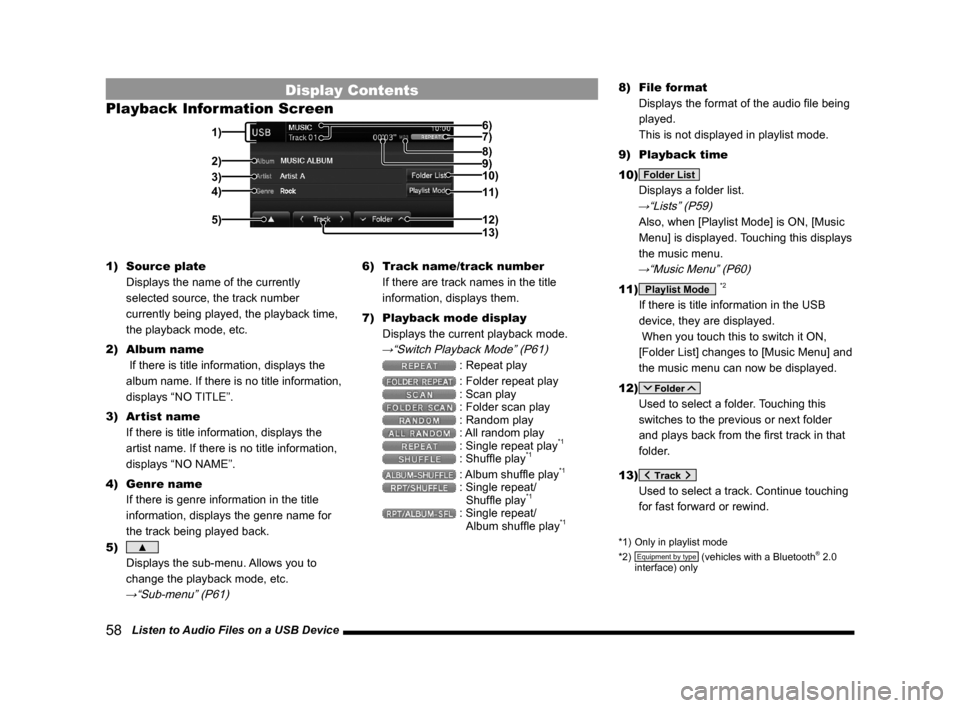
58 Listen to Audio Files on a USB Device
Display Contents
Playback Information Screen
2)
3)
4) 1) 7)
10)11)
12)13) 9)
8)
5)
6)
1) Source plate
Displays the name of the currently
selected source, the track number
currently being played, the playback time,
the playback mode, etc.
2) Album name
If there is title information, displays the
album name. If there is no title information,
displays “NO TITLE”.
3) Artist name
If there is title information, displays the
artist name. If there is no title information,
displays “NO NAME”.
4) Genre name
If there is genre information in the title
information, displays the genre name for
the track being played back.
5)
▲
Displays the sub-menu. Allows you to
change the playback mode, etc.
→“Sub-menu” (P61)
6) Track name/track number
If there are track names in the title
information, displays them.
7) Playback mode display
Displays the current playback mode.
→“Switch Playback Mode” (P61)
: Repeat play
: Folder repeat play : Scan play : Folder scan play : Random play : All random play : Single repeat play*1
: Shuffle play*1
: Album shuffle play*1
: Single repeat/
Shuffle play*1
: Single repeat/ Album shuffle play*1
8) File format
Displays the format of the audio file being
played.
This is not displayed in playlist mode.
9) Playback time
10)
Folder List
Displays a folder list.
→“Lists” (P59)
Also, when [Playlist Mode] is ON, [Music
Menu] is displayed. Touching this displays
the music menu.
→“Music Menu” (P60)
11) Playlist Mode *2
If there is title information in the USB
device, they are displayed.
When you touch this to switch it ON,
[Folder List] changes to [Music Menu] and
the music menu can now be displayed.
12)
Used to select a folder. Touching this
switches to the previous or next folder
and plays back from the first track in that
folder.
13)
Used to select a track. Continue touching
for fast forward or rewind.
*1) Only in playlist mode
*2) Equipment by type (vehicles with a Bluetooth® 2.0
interface) only
13MY_AVC(NAS).indb 582013/02/14 10:57:54
Page 59 of 88
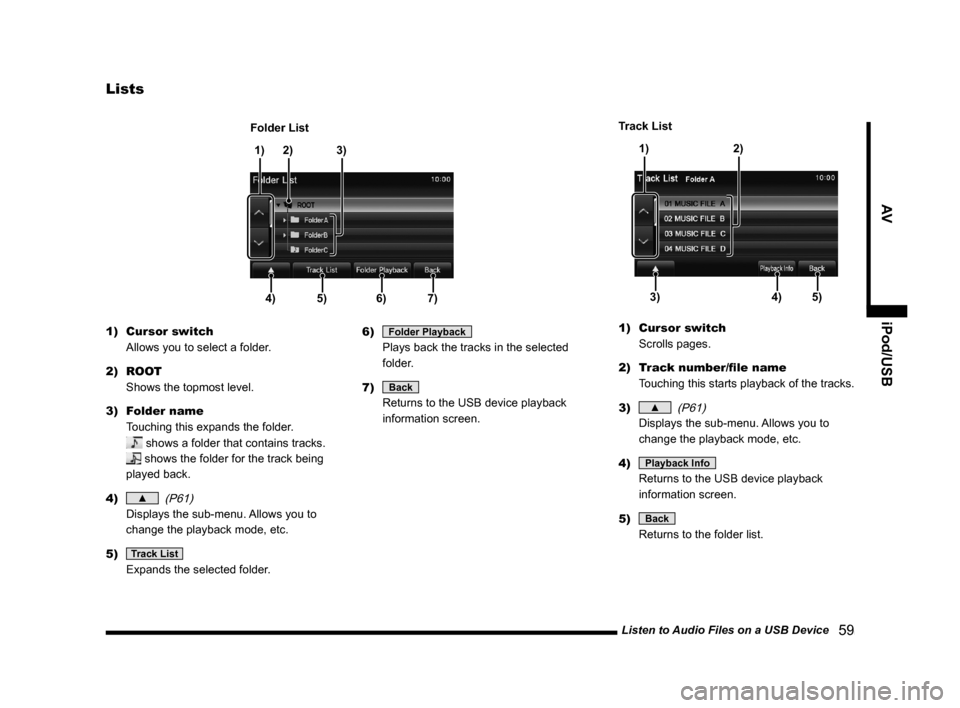
Listen to Audio Files on a USB Device 59
AViPod/USB
Lists
4)5)6)7)
1)2) 3)
Folder Lis t
1) Cursor switch
Allows you to select a folder.
2) ROOT Shows the topmost level.
3) Folder name
Touching this expands the folder.
shows a folder that contains tracks.
shows the folder for the track being
played back.
4)
▲ (P61)
Displays the sub-menu. Allows you to
change the playback mode, etc.
5)
Track List
Expands the selected folder. 6)
Folder Playback
Plays back the tracks in the selected
folder.
7)
Back
Returns to the USB device playback
information screen.
3)4)5)
1) 2)
Track List
1) Cursor switch
Scrolls pages.
2) Track number/file name Touching this starts playback of the tracks.
3)
▲ (P61)
Displays the sub-menu. Allows you to
change the playback mode, etc.
4)
Playback Info
Returns to the USB device playback
information screen.
5)
Back
Returns to the folder list.
13MY_AVC(NAS).indb 592013/02/14 10:57:55
Page 60 of 88
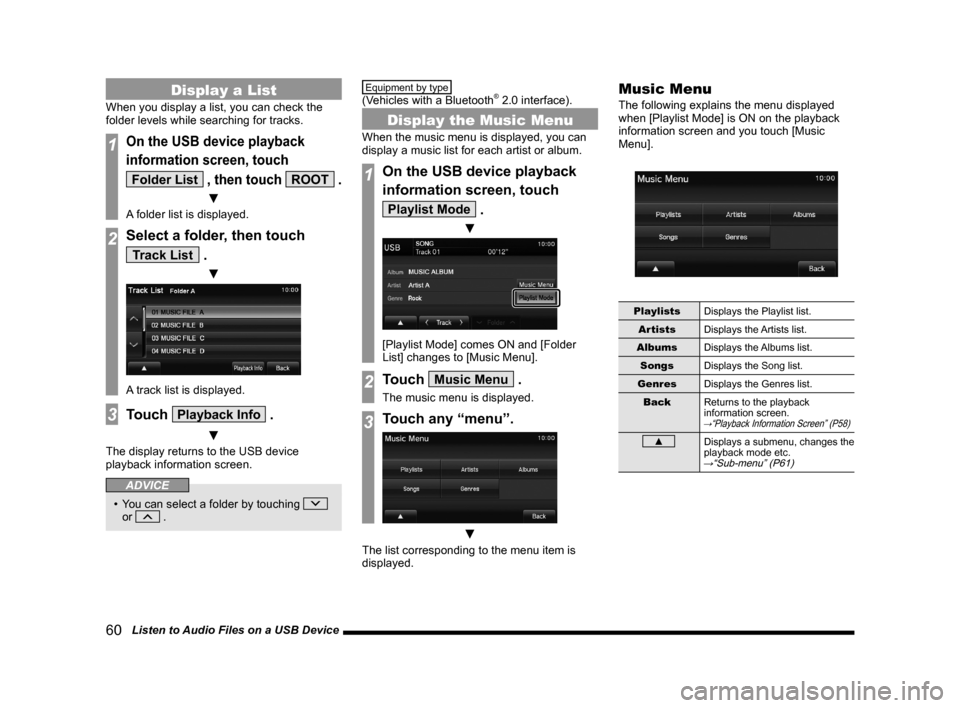
60 Listen to Audio Files on a USB Device
Display a List
When you display a list, you can check the
folder levels while searching for tracks.
1On the USB device playback
information screen, touch
Folder List , then touch ROOT .
▼
A folder list is displayed.
2Select a folder, then touch
Track List .
▼
A track list is displayed.
3Touch Playback Info .
▼
The display returns to the USB device
playback information screen.
ADVICE
• You can select a folder by touching
or .
Equipment by type
(Vehicles with a Bluetooth® 2.0 interface).
Display the Music Menu
When the music menu is displayed, you can
display a music list for each artist or album.
1On the USB device playback
information screen, touch
Playlist Mode .
▼
[Playlist Mode] comes ON and [Folder
List] changes to [Music Menu].
2Touch Music Menu .
The music menu is displayed.
3Touch any “menu”.
▼
The list corresponding to the menu item is
displayed.
Music Menu
The following explains the menu displayed
when [Playlist Mode] is ON on the playback
information screen and you touch [Music
Menu].
Playlists Displays the Playlist list.
Artists Displays the Artists list.
Albums Displays the Albums list.
Songs Displays the Song list.
Genres Displays the Genres list.
Back Returns to the playback
information screen.
→“Playback Information Screen” (P58)
▲ Displays a submenu, changes the
playback mode etc.
→“Sub-menu” (P61)
13MY_AVC(NAS).indb 602013/02/14 10:57:55
Page 61 of 88
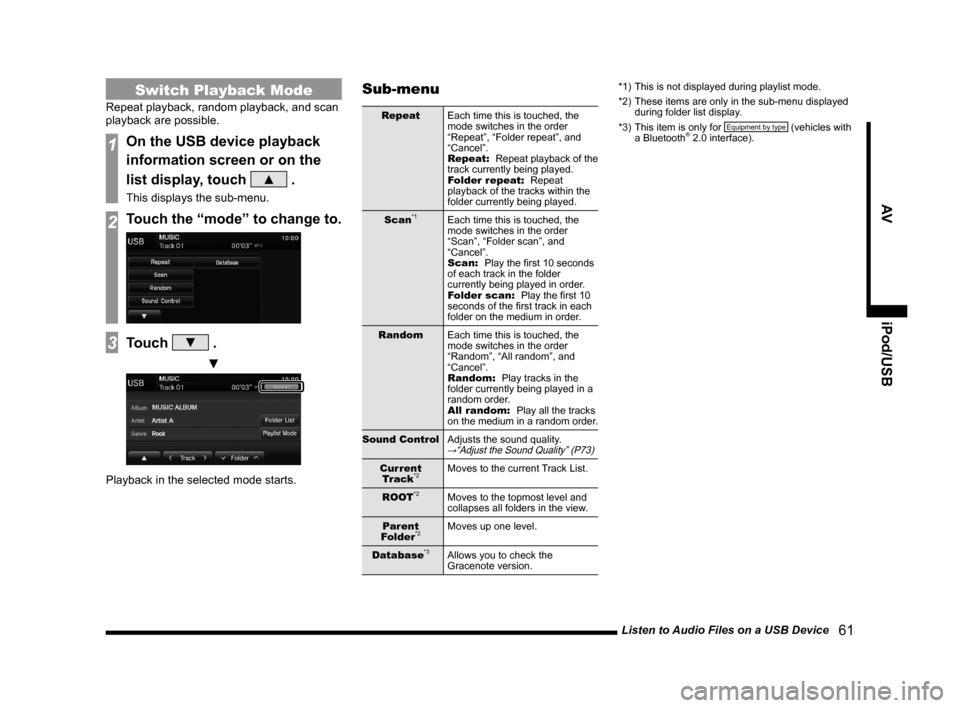
Listen to Audio Files on a USB Device 61
AViPod/USB
Switch Playback Mode
Repeat playback, random playback, and scan
playback are possible.
1On the USB device playback
information screen or on the
list display, touch
▲ .
This displays the sub-menu.
2Touch the “mode” to change to.
3Touch ▼ .
▼
Playback in the selected mode starts.
Sub-menu
RepeatEach time this is touched, the
mode switches in the order
“Repeat”, “Folder repeat”, and
“Cancel”.
Repeat: Repeat playback of the
track currently being played.
Folder repeat: Repeat
playback of the tracks within the
folder currently being played.
Scan
*1Each time this is touched, the
mode switches in the order
“Scan”, “Folder scan”, and
“Cancel”.
Scan: Play the first 10 seconds
of each track in the folder
currently being played in order.
Folder scan: Play the first 10
seconds of the first track in each
folder on the medium in order.
Random Each time this is touched, the
mode switches in the order
“Random”, “All random”, and
“Cancel”.
Random: Play tracks in the
folder currently being played in a
random order.
All random: Play all the tracks
on the medium in a random order.
Sound Control Adjusts the sound quality.
→“Adjust the Sound Quality” (P73)
Current
Tr ack*2Moves to the current Track List.
ROOT
*2Moves to the topmost level and
collapses all folders in the view.
Parent
Folder
*2Moves up one level.
Database
*3Allows you to check the
Gracenote version. *1)
This is not displayed during playlist mode.
*2) These items are only in the sub-menu displayed
during folder list display.
*3) This item is only for
Equipment by type (vehicles with
a Bluetooth® 2.0 interface).
13MY_AVC(NAS).indb 612013/02/14 10:57:56
Page 72 of 88
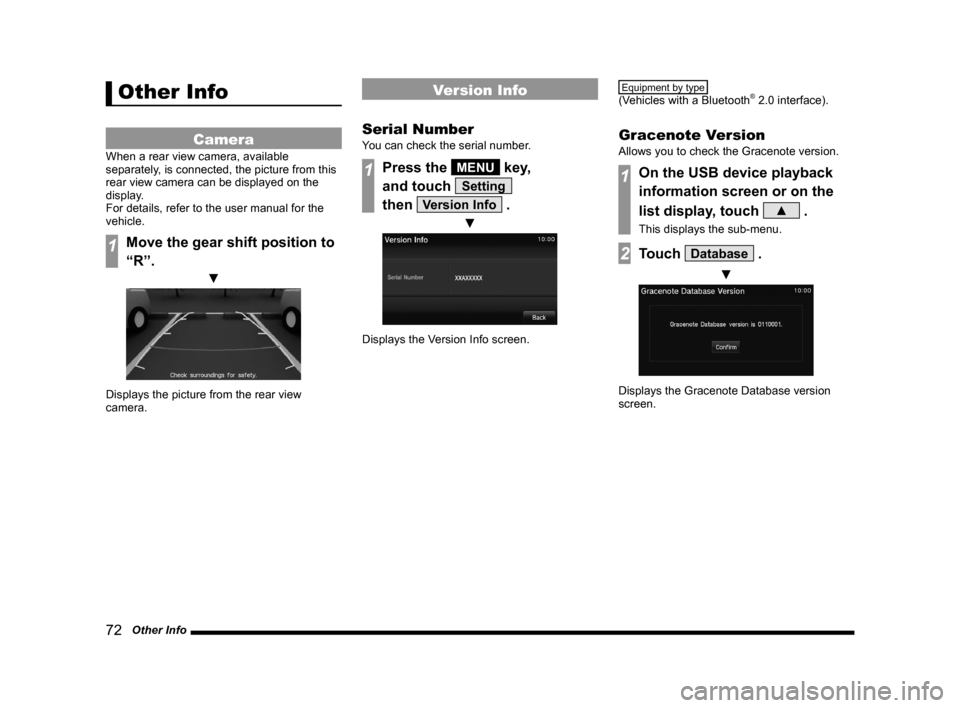
72 Other Info
Other Info
Camera
When a rear view camera, available
separately, is connected, the picture from this
rear view camera can be displayed on the
display.
For details, refer to the user manual for the
vehicle.
1Move the gear shift position to
“R”.
▼
Displays the picture from the rear view
camera.
Version Info
Serial Number
You can check the serial number.
1Press the MENU key,
and touch
Setting
then
Version Info .
▼
Displays the Version Info screen.
Equipment by type
(Vehicles with a Bluetooth® 2.0 interface).
Gracenote Version
Allows you to check the Gracenote version.
1On the USB device playback
information screen or on the
list display, touch
▲ .
This displays the sub-menu.
2Touch Database .
▼
Displays the Gracenote Database version
screen.
13MY_AVC(NAS).indb 722013/02/14 10:58:03
Page 83 of 88
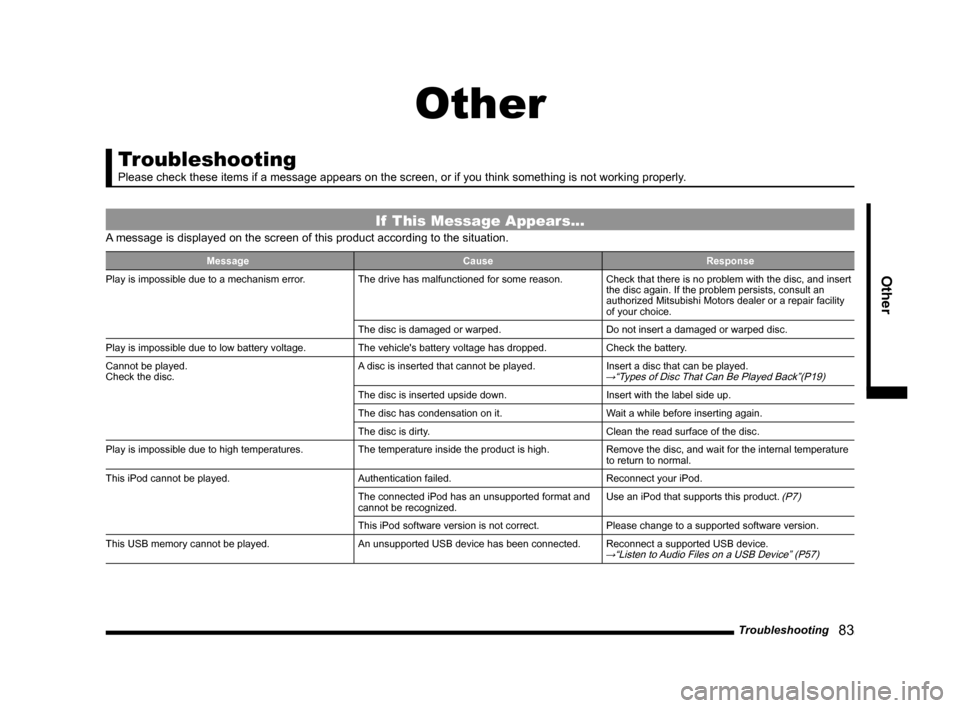
Troubleshooting 83
Other
Other
Troubleshooting
Please check these items if a message appears on the screen, or if you t\
hink something is not working properly.
If This Message Appears...
A message is displayed on the screen of this product according to the sit\
uation.
Message CauseResponse
Play is impossible due to a mechanism error. The drive has malfunctioned for some reason.Check that there is no problem with the disc, and insert
the disc again. If the problem persists, consult an
authorized Mitsubishi Motors dealer or a repair facility
of your choice.
The disc is damaged or warped. Do not insert a damaged or warped disc.
Play is impossible due to low battery voltage. The vehicle's battery voltage has dropped.Check the battery.
Cannot be played.
Check the disc. A disc is inserted that cannot be played.
Insert a disc that can be played.
→“Types of Disc That Can Be Played Back”(P19)
The disc is inserted upside down. Insert with the label side up.
The disc has condensation on it. Wait a while before inserting again.
The disc is dirty. Clean the read surface of the disc.
Play is impossible due to high temperatures. The temperature inside the product is high.Remove the disc, and wait for the internal temperature
to return to normal.
This iPod cannot be played. Authentication failed.Reconnect your iPod.
The connected iPod has an unsupported format and
cannot be recognized. Use an iPod that supports this product.
(P7)
This iPod software version is not correct.
Please change to a supported software version.
This USB memory cannot be played. An unsupported USB device has been connected.Reconnect a supported USB device.
→“Listen to Audio Files on a USB Device” (P57)
13MY_AVC(NAS).indb 832013/02/14 10:58:08